Understanding Management: Functions, Culture, and Strategies Report
VerifiedAdded on 2021/04/16
|10
|2100
|26
Report
AI Summary
This report provides an in-depth analysis of the management practices within a cleaning service business. It begins by outlining the four key functions of management: planning, organizing, leading, and controlling, demonstrating how these functions are applied in the day-to-day operations of the business. The report then explores the business's structure, emphasizing the importance of a suitable business name, licenses, insurance, legal considerations, and funding. The analysis continues with an examination of the company's organizational culture, identifying it as a power culture based on Charles Handy's model, and discussing the implications of this culture on the business. Finally, the report details four strategies for effective communication within the business: developing basic skills, generating feedback, organizing monthly meetings, and utilizing technology. The report concludes by highlighting the importance of these strategies in fostering effective communication and avoiding conflicts, providing a comprehensive overview of the management aspects of the cleaning service business.
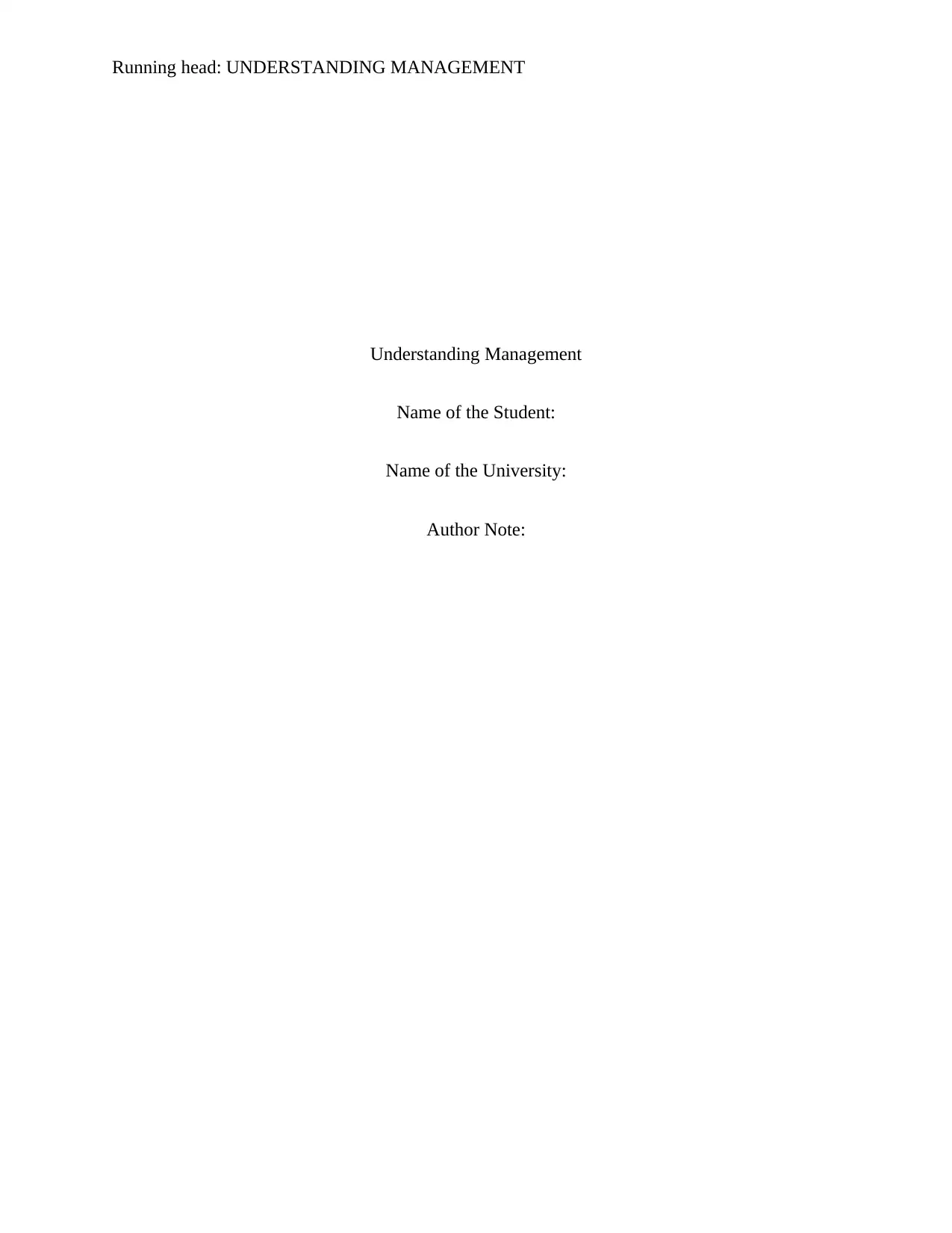
Running head: UNDERSTANDING MANAGEMENT
Understanding Management
Name of the Student:
Name of the University:
Author Note:
Understanding Management
Name of the Student:
Name of the University:
Author Note:
Paraphrase This Document
Need a fresh take? Get an instant paraphrase of this document with our AI Paraphraser

1UNDERSTANDING MANAGEMENT
Table of Contents
Task 1: Four Functions of Management in Determining Day to Day Business Operations...........2
Task 2: Possible Structure of Business and its Relevance in Achieving Business Goals...............3
Task 3: Culture of the Business Based on Handy's Model and Its Importance...............................5
Task 4: Four Strategies for Effective Communication....................................................................6
References:......................................................................................................................................8
Table of Contents
Task 1: Four Functions of Management in Determining Day to Day Business Operations...........2
Task 2: Possible Structure of Business and its Relevance in Achieving Business Goals...............3
Task 3: Culture of the Business Based on Handy's Model and Its Importance...............................5
Task 4: Four Strategies for Effective Communication....................................................................6
References:......................................................................................................................................8
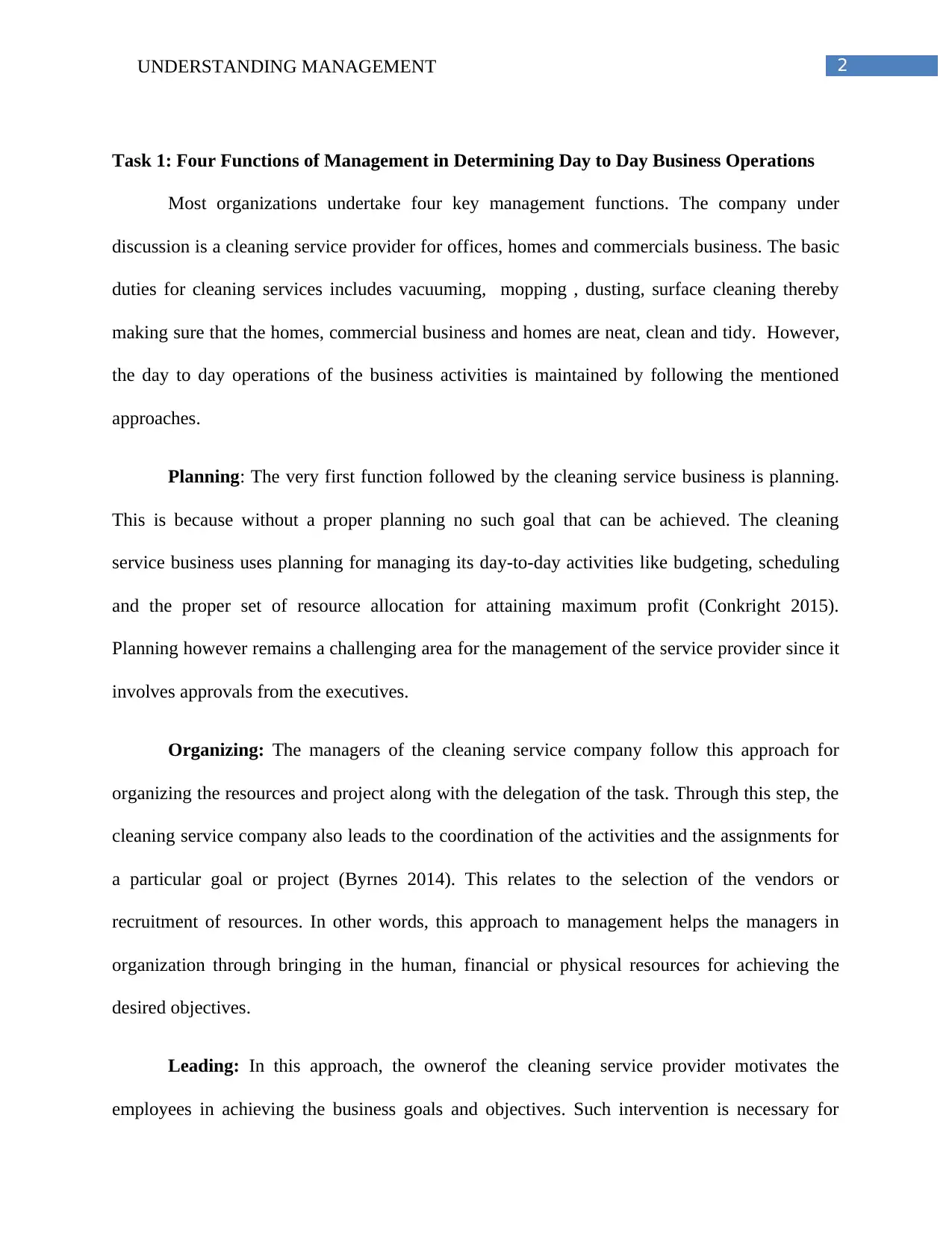
2UNDERSTANDING MANAGEMENT
Task 1: Four Functions of Management in Determining Day to Day Business Operations
Most organizations undertake four key management functions. The company under
discussion is a cleaning service provider for offices, homes and commercials business. The basic
duties for cleaning services includes vacuuming, mopping , dusting, surface cleaning thereby
making sure that the homes, commercial business and homes are neat, clean and tidy. However,
the day to day operations of the business activities is maintained by following the mentioned
approaches.
Planning: The very first function followed by the cleaning service business is planning.
This is because without a proper planning no such goal that can be achieved. The cleaning
service business uses planning for managing its day-to-day activities like budgeting, scheduling
and the proper set of resource allocation for attaining maximum profit (Conkright 2015).
Planning however remains a challenging area for the management of the service provider since it
involves approvals from the executives.
Organizing: The managers of the cleaning service company follow this approach for
organizing the resources and project along with the delegation of the task. Through this step, the
cleaning service company also leads to the coordination of the activities and the assignments for
a particular goal or project (Byrnes 2014). This relates to the selection of the vendors or
recruitment of resources. In other words, this approach to management helps the managers in
organization through bringing in the human, financial or physical resources for achieving the
desired objectives.
Leading: In this approach, the ownerof the cleaning service provider motivates the
employees in achieving the business goals and objectives. Such intervention is necessary for
Task 1: Four Functions of Management in Determining Day to Day Business Operations
Most organizations undertake four key management functions. The company under
discussion is a cleaning service provider for offices, homes and commercials business. The basic
duties for cleaning services includes vacuuming, mopping , dusting, surface cleaning thereby
making sure that the homes, commercial business and homes are neat, clean and tidy. However,
the day to day operations of the business activities is maintained by following the mentioned
approaches.
Planning: The very first function followed by the cleaning service business is planning.
This is because without a proper planning no such goal that can be achieved. The cleaning
service business uses planning for managing its day-to-day activities like budgeting, scheduling
and the proper set of resource allocation for attaining maximum profit (Conkright 2015).
Planning however remains a challenging area for the management of the service provider since it
involves approvals from the executives.
Organizing: The managers of the cleaning service company follow this approach for
organizing the resources and project along with the delegation of the task. Through this step, the
cleaning service company also leads to the coordination of the activities and the assignments for
a particular goal or project (Byrnes 2014). This relates to the selection of the vendors or
recruitment of resources. In other words, this approach to management helps the managers in
organization through bringing in the human, financial or physical resources for achieving the
desired objectives.
Leading: In this approach, the ownerof the cleaning service provider motivates the
employees in achieving the business goals and objectives. Such intervention is necessary for
⊘ This is a preview!⊘
Do you want full access?
Subscribe today to unlock all pages.

Trusted by 1+ million students worldwide
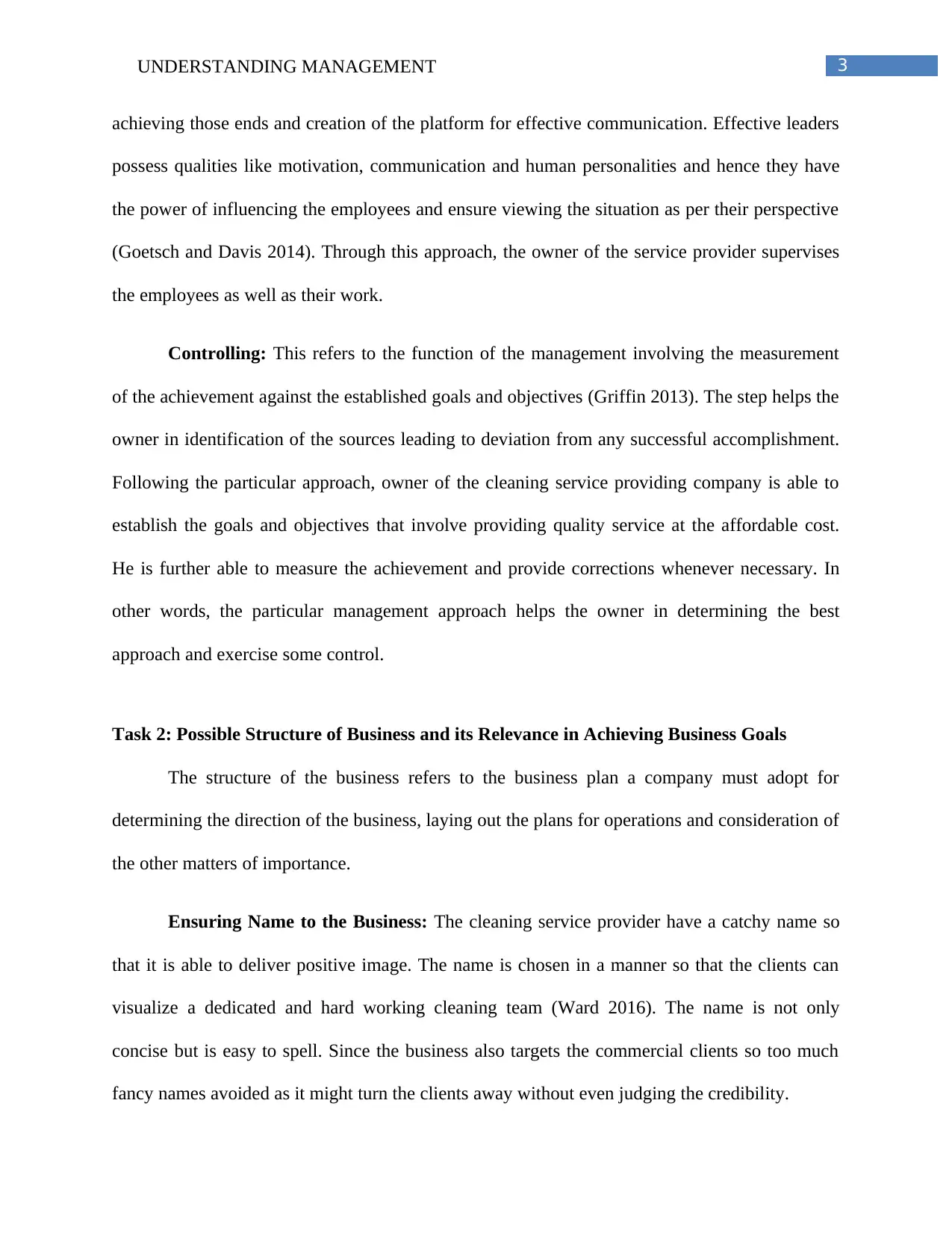
3UNDERSTANDING MANAGEMENT
achieving those ends and creation of the platform for effective communication. Effective leaders
possess qualities like motivation, communication and human personalities and hence they have
the power of influencing the employees and ensure viewing the situation as per their perspective
(Goetsch and Davis 2014). Through this approach, the owner of the service provider supervises
the employees as well as their work.
Controlling: This refers to the function of the management involving the measurement
of the achievement against the established goals and objectives (Griffin 2013). The step helps the
owner in identification of the sources leading to deviation from any successful accomplishment.
Following the particular approach, owner of the cleaning service providing company is able to
establish the goals and objectives that involve providing quality service at the affordable cost.
He is further able to measure the achievement and provide corrections whenever necessary. In
other words, the particular management approach helps the owner in determining the best
approach and exercise some control.
Task 2: Possible Structure of Business and its Relevance in Achieving Business Goals
The structure of the business refers to the business plan a company must adopt for
determining the direction of the business, laying out the plans for operations and consideration of
the other matters of importance.
Ensuring Name to the Business: The cleaning service provider have a catchy name so
that it is able to deliver positive image. The name is chosen in a manner so that the clients can
visualize a dedicated and hard working cleaning team (Ward 2016). The name is not only
concise but is easy to spell. Since the business also targets the commercial clients so too much
fancy names avoided as it might turn the clients away without even judging the credibility.
achieving those ends and creation of the platform for effective communication. Effective leaders
possess qualities like motivation, communication and human personalities and hence they have
the power of influencing the employees and ensure viewing the situation as per their perspective
(Goetsch and Davis 2014). Through this approach, the owner of the service provider supervises
the employees as well as their work.
Controlling: This refers to the function of the management involving the measurement
of the achievement against the established goals and objectives (Griffin 2013). The step helps the
owner in identification of the sources leading to deviation from any successful accomplishment.
Following the particular approach, owner of the cleaning service providing company is able to
establish the goals and objectives that involve providing quality service at the affordable cost.
He is further able to measure the achievement and provide corrections whenever necessary. In
other words, the particular management approach helps the owner in determining the best
approach and exercise some control.
Task 2: Possible Structure of Business and its Relevance in Achieving Business Goals
The structure of the business refers to the business plan a company must adopt for
determining the direction of the business, laying out the plans for operations and consideration of
the other matters of importance.
Ensuring Name to the Business: The cleaning service provider have a catchy name so
that it is able to deliver positive image. The name is chosen in a manner so that the clients can
visualize a dedicated and hard working cleaning team (Ward 2016). The name is not only
concise but is easy to spell. Since the business also targets the commercial clients so too much
fancy names avoided as it might turn the clients away without even judging the credibility.
Paraphrase This Document
Need a fresh take? Get an instant paraphrase of this document with our AI Paraphraser

4UNDERSTANDING MANAGEMENT
Getting Licenses: A business license is necessary and is used for the purposes of tax and
identification. Since the cleaning service provider is in business for the past ten years, so before
applying for the licenses it has undergone a checking for the local and state area (Blank 2013).
After finding out the requirements of the locality, the business has applied and followed it
through. Over the years, the family owned business of cleaning service provider has paid the
required fees for maintenance of the proper licensing by keeping in mind the finance and budget
of the company.
Implementing Insurance: As the business of a cleaning service provider, involves
working on the property of someone so the business has investment on insurance liability. This is
necessary for avoiding any risk associated with the damage of the property of the customer,
falling out from the ladder, dealing with potential number of lawsuits and accusations of theft
(Blackburn, Hart and Wainwright 2013). Otherwise, the business needs to pay expensive fees for
legal issues that could lead the company in a state of bankruptcy. The business has thus prepared
before hand for tackling the problems before they even arise.
Consideration of Legal Issues: The cleaning services business provider address
important issue related to health and safety, contracts, policies and employees. The cleaning
service business have ensured standards for meeting the safety and protection of the health of
the employees while dealing with the hazardous substance along with a variety of regulations
pertaining to the business(Burns 2016). The company also ensured entering into one especially
with the commercial clients who goes for routine cleaning services so that the paid along with
avoidance of the legal matters. The company also presents its policies in the written form to the
customers so that they have a clear idea of the business. Moreover, the company also hires
employees through a proper background check.
Getting Licenses: A business license is necessary and is used for the purposes of tax and
identification. Since the cleaning service provider is in business for the past ten years, so before
applying for the licenses it has undergone a checking for the local and state area (Blank 2013).
After finding out the requirements of the locality, the business has applied and followed it
through. Over the years, the family owned business of cleaning service provider has paid the
required fees for maintenance of the proper licensing by keeping in mind the finance and budget
of the company.
Implementing Insurance: As the business of a cleaning service provider, involves
working on the property of someone so the business has investment on insurance liability. This is
necessary for avoiding any risk associated with the damage of the property of the customer,
falling out from the ladder, dealing with potential number of lawsuits and accusations of theft
(Blackburn, Hart and Wainwright 2013). Otherwise, the business needs to pay expensive fees for
legal issues that could lead the company in a state of bankruptcy. The business has thus prepared
before hand for tackling the problems before they even arise.
Consideration of Legal Issues: The cleaning services business provider address
important issue related to health and safety, contracts, policies and employees. The cleaning
service business have ensured standards for meeting the safety and protection of the health of
the employees while dealing with the hazardous substance along with a variety of regulations
pertaining to the business(Burns 2016). The company also ensured entering into one especially
with the commercial clients who goes for routine cleaning services so that the paid along with
avoidance of the legal matters. The company also presents its policies in the written form to the
customers so that they have a clear idea of the business. Moreover, the company also hires
employees through a proper background check.
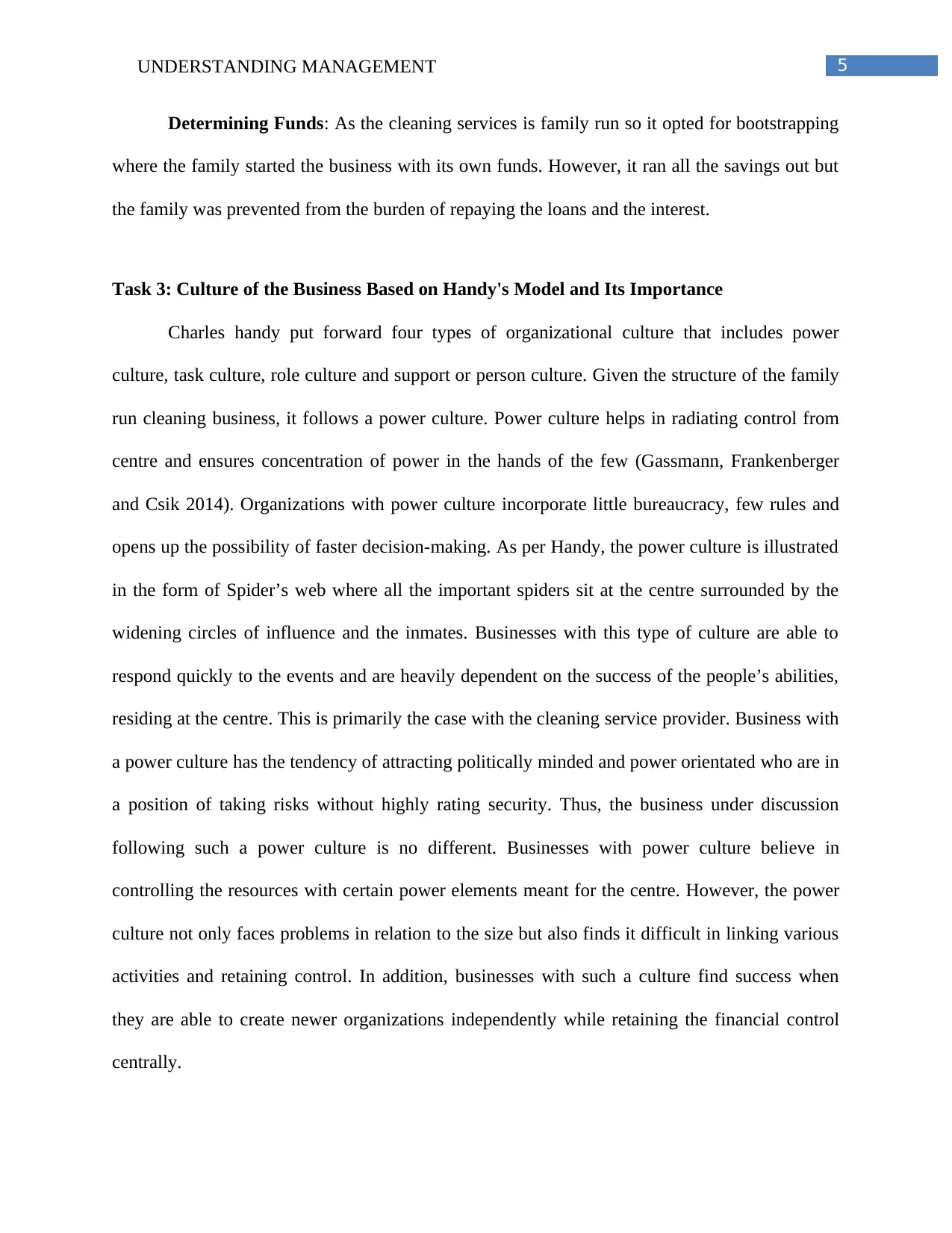
5UNDERSTANDING MANAGEMENT
Determining Funds: As the cleaning services is family run so it opted for bootstrapping
where the family started the business with its own funds. However, it ran all the savings out but
the family was prevented from the burden of repaying the loans and the interest.
Task 3: Culture of the Business Based on Handy's Model and Its Importance
Charles handy put forward four types of organizational culture that includes power
culture, task culture, role culture and support or person culture. Given the structure of the family
run cleaning business, it follows a power culture. Power culture helps in radiating control from
centre and ensures concentration of power in the hands of the few (Gassmann, Frankenberger
and Csik 2014). Organizations with power culture incorporate little bureaucracy, few rules and
opens up the possibility of faster decision-making. As per Handy, the power culture is illustrated
in the form of Spider’s web where all the important spiders sit at the centre surrounded by the
widening circles of influence and the inmates. Businesses with this type of culture are able to
respond quickly to the events and are heavily dependent on the success of the people’s abilities,
residing at the centre. This is primarily the case with the cleaning service provider. Business with
a power culture has the tendency of attracting politically minded and power orientated who are in
a position of taking risks without highly rating security. Thus, the business under discussion
following such a power culture is no different. Businesses with power culture believe in
controlling the resources with certain power elements meant for the centre. However, the power
culture not only faces problems in relation to the size but also finds it difficult in linking various
activities and retaining control. In addition, businesses with such a culture find success when
they are able to create newer organizations independently while retaining the financial control
centrally.
Determining Funds: As the cleaning services is family run so it opted for bootstrapping
where the family started the business with its own funds. However, it ran all the savings out but
the family was prevented from the burden of repaying the loans and the interest.
Task 3: Culture of the Business Based on Handy's Model and Its Importance
Charles handy put forward four types of organizational culture that includes power
culture, task culture, role culture and support or person culture. Given the structure of the family
run cleaning business, it follows a power culture. Power culture helps in radiating control from
centre and ensures concentration of power in the hands of the few (Gassmann, Frankenberger
and Csik 2014). Organizations with power culture incorporate little bureaucracy, few rules and
opens up the possibility of faster decision-making. As per Handy, the power culture is illustrated
in the form of Spider’s web where all the important spiders sit at the centre surrounded by the
widening circles of influence and the inmates. Businesses with this type of culture are able to
respond quickly to the events and are heavily dependent on the success of the people’s abilities,
residing at the centre. This is primarily the case with the cleaning service provider. Business with
a power culture has the tendency of attracting politically minded and power orientated who are in
a position of taking risks without highly rating security. Thus, the business under discussion
following such a power culture is no different. Businesses with power culture believe in
controlling the resources with certain power elements meant for the centre. However, the power
culture not only faces problems in relation to the size but also finds it difficult in linking various
activities and retaining control. In addition, businesses with such a culture find success when
they are able to create newer organizations independently while retaining the financial control
centrally.
⊘ This is a preview!⊘
Do you want full access?
Subscribe today to unlock all pages.

Trusted by 1+ million students worldwide

6UNDERSTANDING MANAGEMENT
The cleaning service provider heavily depends on the service provided by the individuals
and their performance judged on the outcome of the service provided, which one of the criteria
for power culture (Russo et al., 2013). In addition, the cleaning service provider is also abrasive
and tough and believes in higher turnover thereby aligning it with the criteria of power culture.
Employees working for a business with power culture are able to anticipate the expectation of
the power holders. The power culture of the family run cleaning service business has resulted in
a happy state that resulted in stronger commitment towards the corporate goals.
Task 4: Four Strategies for Effective Communication
The strategies adopted for ensuring effective communication in businesses and which also
help in avoiding conflict includes:
Development of the Basic Skills:
This happens with the mastering of the essential skills that includes, speaking, listening,
asking necessary questions and providing necessary feedback (Goetsch and Davis 2014). This
will provide the employees with a feel that the channels for communication are open and they
have necessary inputs towards their job roles and the direction of the organization.
Generation of Feedback:
Effective communication is ensured by making the employees complete the written weekly
status. This also provides them with an opportunity for providing the managers with a synopsis
of the activities performed for the mentioned week and accordingly plan for the upcoming week.
The cleaning service provider heavily depends on the service provided by the individuals
and their performance judged on the outcome of the service provided, which one of the criteria
for power culture (Russo et al., 2013). In addition, the cleaning service provider is also abrasive
and tough and believes in higher turnover thereby aligning it with the criteria of power culture.
Employees working for a business with power culture are able to anticipate the expectation of
the power holders. The power culture of the family run cleaning service business has resulted in
a happy state that resulted in stronger commitment towards the corporate goals.
Task 4: Four Strategies for Effective Communication
The strategies adopted for ensuring effective communication in businesses and which also
help in avoiding conflict includes:
Development of the Basic Skills:
This happens with the mastering of the essential skills that includes, speaking, listening,
asking necessary questions and providing necessary feedback (Goetsch and Davis 2014). This
will provide the employees with a feel that the channels for communication are open and they
have necessary inputs towards their job roles and the direction of the organization.
Generation of Feedback:
Effective communication is ensured by making the employees complete the written weekly
status. This also provides them with an opportunity for providing the managers with a synopsis
of the activities performed for the mentioned week and accordingly plan for the upcoming week.
Paraphrase This Document
Need a fresh take? Get an instant paraphrase of this document with our AI Paraphraser
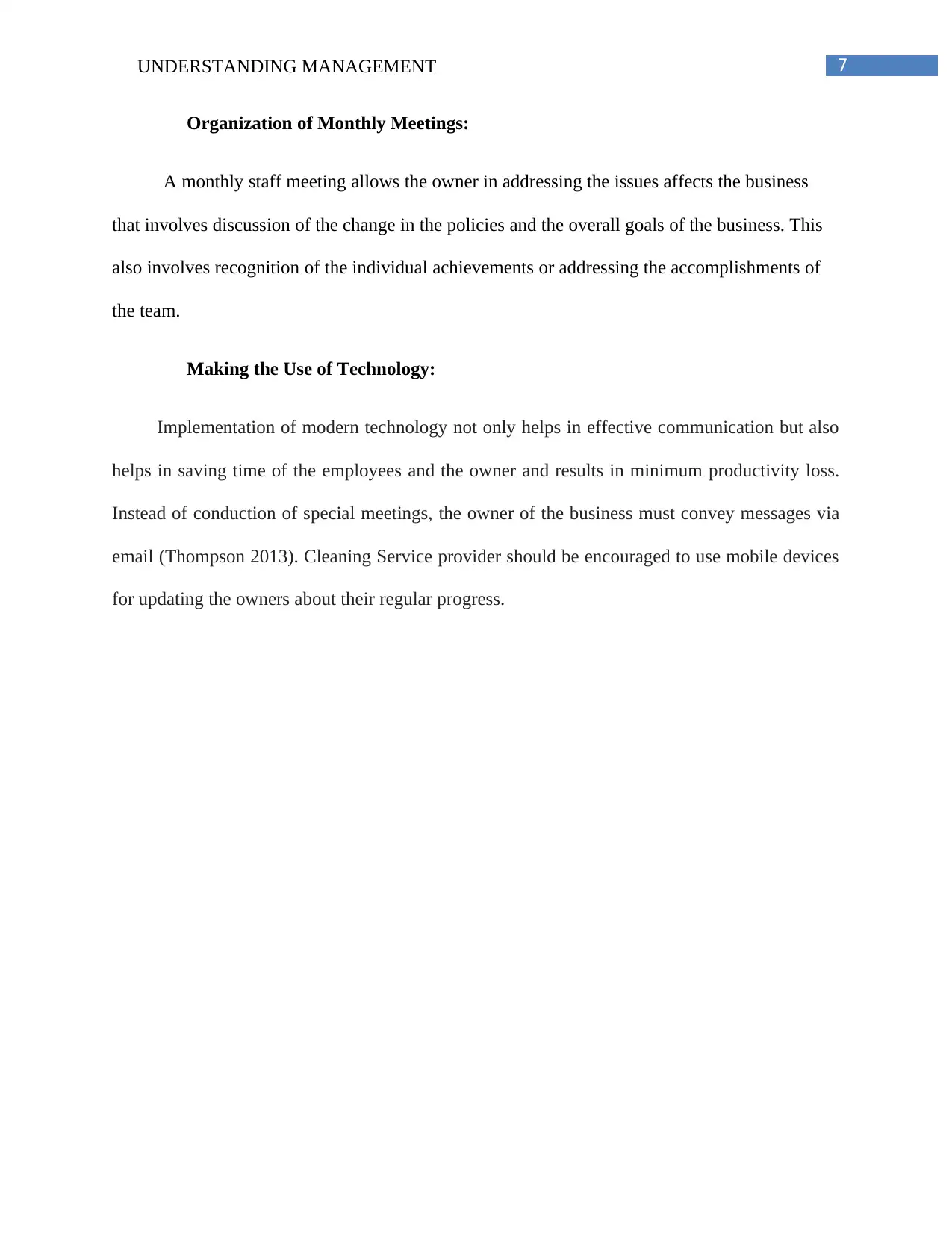
7UNDERSTANDING MANAGEMENT
Organization of Monthly Meetings:
A monthly staff meeting allows the owner in addressing the issues affects the business
that involves discussion of the change in the policies and the overall goals of the business. This
also involves recognition of the individual achievements or addressing the accomplishments of
the team.
Making the Use of Technology:
Implementation of modern technology not only helps in effective communication but also
helps in saving time of the employees and the owner and results in minimum productivity loss.
Instead of conduction of special meetings, the owner of the business must convey messages via
email (Thompson 2013). Cleaning Service provider should be encouraged to use mobile devices
for updating the owners about their regular progress.
Organization of Monthly Meetings:
A monthly staff meeting allows the owner in addressing the issues affects the business
that involves discussion of the change in the policies and the overall goals of the business. This
also involves recognition of the individual achievements or addressing the accomplishments of
the team.
Making the Use of Technology:
Implementation of modern technology not only helps in effective communication but also
helps in saving time of the employees and the owner and results in minimum productivity loss.
Instead of conduction of special meetings, the owner of the business must convey messages via
email (Thompson 2013). Cleaning Service provider should be encouraged to use mobile devices
for updating the owners about their regular progress.

8UNDERSTANDING MANAGEMENT
References:
Blackburn, R.A., Hart, M. and Wainwright, T., 2013. Small business performance: business,
strategy and owner-manager characteristics. Journal of small business and enterprise
development, 20(1), pp.8-27.
Blank, S., 2013. Why the lean start-up changes everything. Harvard business review, 91(5),
pp.63-72.
Burns, P., 2016. Entrepreneurship and small business. Palgrave Macmillan Limited.
Byrnes, W.J., 2014. Management and the Arts. Focal Press.
Conkright, T.A., 2015. Using the four functions of management for sustainable employee
engagement. Performance Improvement, 54(8), pp.15-21.
Gassmann, O., Frankenberger, K. and Csik, M., 2014. Revolutionizing the business model.
In Management of the fuzzy front end of innovation (pp. 89-97). Springer, Cham.
Goetsch, D.L. and Davis, S.B., 2014. Quality management for organizational excellence. Upper
Saddle River, NJ: pearson.
Goetsch, D.L. and Davis, S.B., 2014. Quality management for organizational excellence. Upper
Saddle River, NJ: pearson.
Griffin, R.W., 2013. Fundamentals of management. Cengage Learning.
References:
Blackburn, R.A., Hart, M. and Wainwright, T., 2013. Small business performance: business,
strategy and owner-manager characteristics. Journal of small business and enterprise
development, 20(1), pp.8-27.
Blank, S., 2013. Why the lean start-up changes everything. Harvard business review, 91(5),
pp.63-72.
Burns, P., 2016. Entrepreneurship and small business. Palgrave Macmillan Limited.
Byrnes, W.J., 2014. Management and the Arts. Focal Press.
Conkright, T.A., 2015. Using the four functions of management for sustainable employee
engagement. Performance Improvement, 54(8), pp.15-21.
Gassmann, O., Frankenberger, K. and Csik, M., 2014. Revolutionizing the business model.
In Management of the fuzzy front end of innovation (pp. 89-97). Springer, Cham.
Goetsch, D.L. and Davis, S.B., 2014. Quality management for organizational excellence. Upper
Saddle River, NJ: pearson.
Goetsch, D.L. and Davis, S.B., 2014. Quality management for organizational excellence. Upper
Saddle River, NJ: pearson.
Griffin, R.W., 2013. Fundamentals of management. Cengage Learning.
⊘ This is a preview!⊘
Do you want full access?
Subscribe today to unlock all pages.

Trusted by 1+ million students worldwide

9UNDERSTANDING MANAGEMENT
Russo, G.M., Tomei, P.A., Linhares, A.B.J. and Santos, A.M., 2013. Correlation Between
Organizational Culture and Compensation Strategies Using Charles Handy's
Typology. Performance Improvement, 52(7), pp.13-21.
Thompson, P., 2013. The digital natives as learners: Technology use patterns and approaches to
learning. Computers & Education, 65, pp.12-33.
Ward, J., 2016. Keeping the family business healthy: How to plan for continuing growth,
profitability, and family leadership. Springer.
Russo, G.M., Tomei, P.A., Linhares, A.B.J. and Santos, A.M., 2013. Correlation Between
Organizational Culture and Compensation Strategies Using Charles Handy's
Typology. Performance Improvement, 52(7), pp.13-21.
Thompson, P., 2013. The digital natives as learners: Technology use patterns and approaches to
learning. Computers & Education, 65, pp.12-33.
Ward, J., 2016. Keeping the family business healthy: How to plan for continuing growth,
profitability, and family leadership. Springer.
1 out of 10
Related Documents
Your All-in-One AI-Powered Toolkit for Academic Success.
+13062052269
info@desklib.com
Available 24*7 on WhatsApp / Email
![[object Object]](/_next/static/media/star-bottom.7253800d.svg)
Unlock your academic potential
Copyright © 2020–2025 A2Z Services. All Rights Reserved. Developed and managed by ZUCOL.





